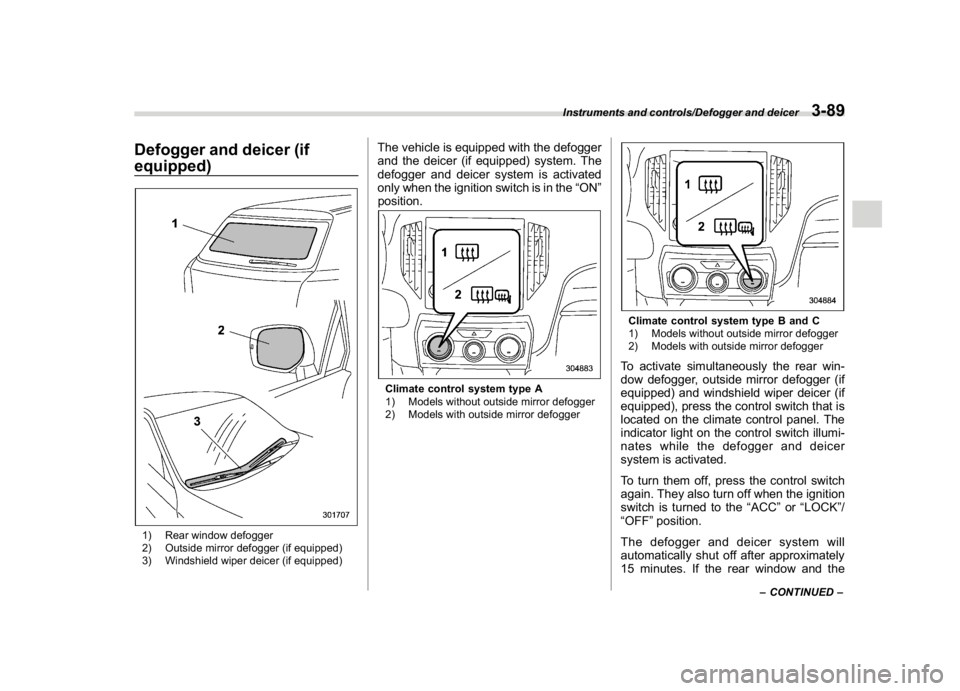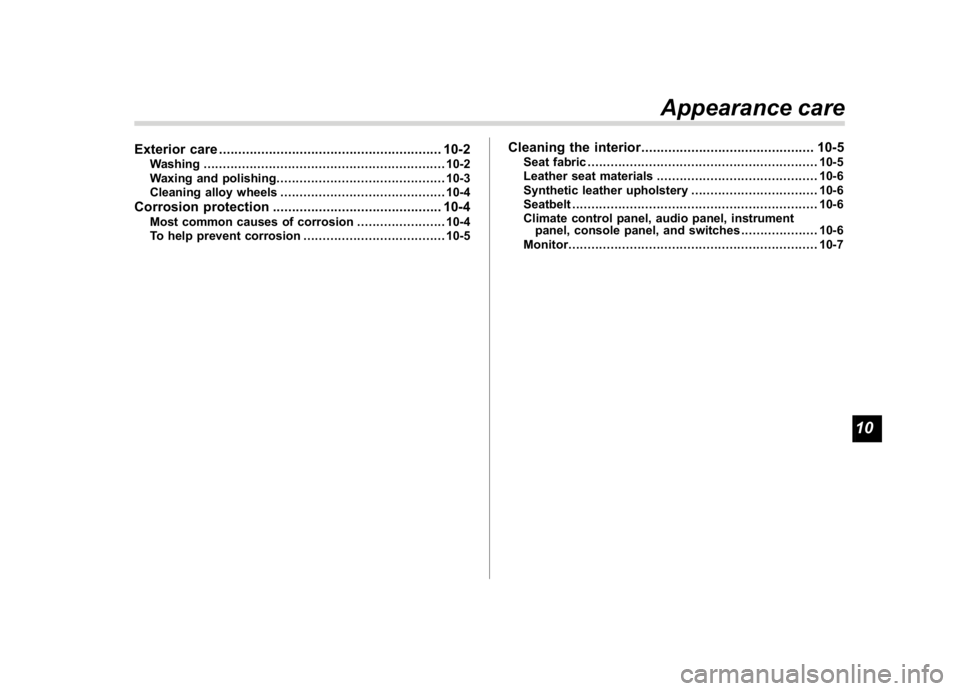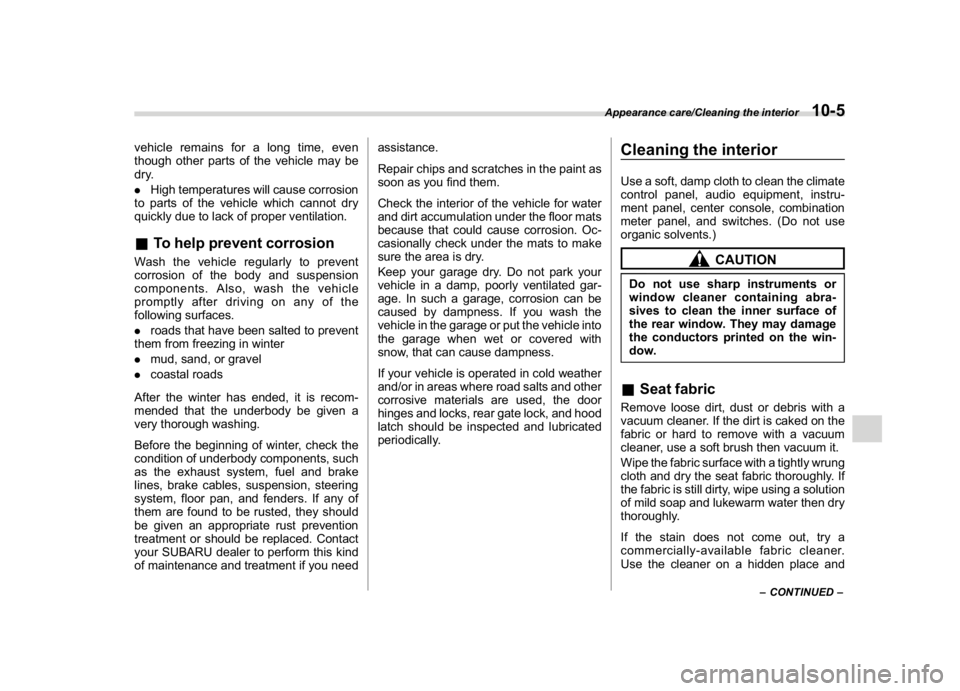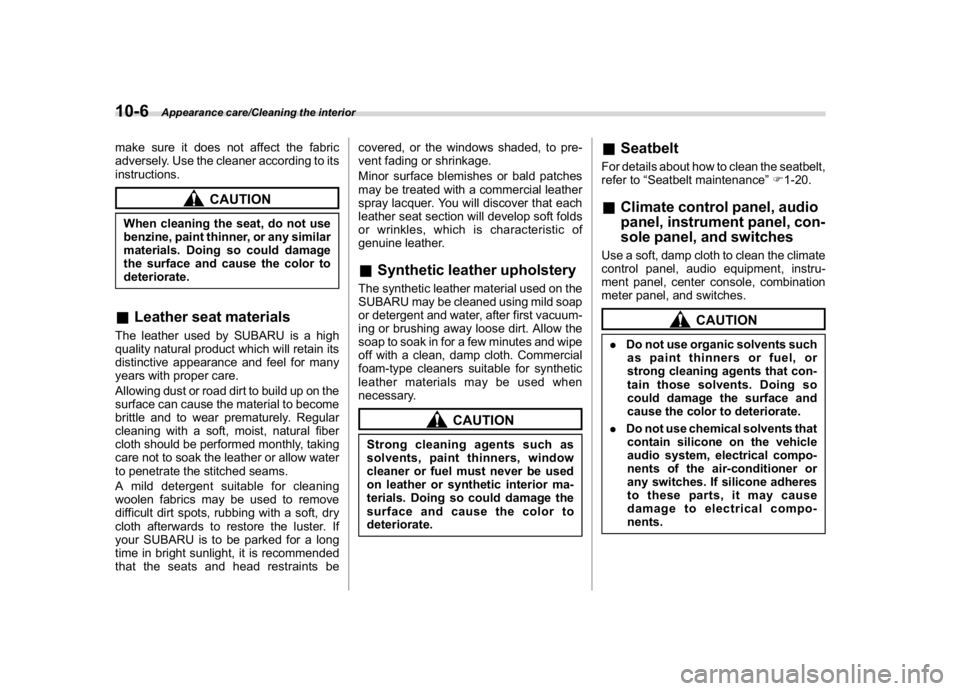2018 SUBARU CROSSTREK instrument panel
[x] Cancel search: instrument panelPage 222 of 474

(227,1)
北米Model "A1320BE-C" EDITED: 2017/ 10/ 10
Defogger and deicer (if
equipped)1) Rear window defogger
2) Outside mirror defogger (if equipped)
3) Windshield wiper deicer (if equipped)
The vehicle is equipped with the defogger
and the deicer (if equipped) system. The
defogger and deicer system is activated
only when the ignition switch is in the“ON”
position.Climate control system type A
1) Models without outside mirror defogger
2) Models with outside mirror defogger
Climate control system type B and C
1) Models without outside mirror defogger
2) Models with outside mirror defoggerTo activate simultaneously the rear win-
dow defogger, outside mirror defogger (if
equipped) and windshield wiper deicer (if
equipped), press the control switch that is
located on the climate control panel. The
indicator light on the control switch illumi-
nates while the defogger and deicer
system is activated.
To turn them off, press the control switch
again. They also turn off when the ignition
switch is turned to the“ACC”or“LOCK”/
“OFF”position.
The defogger and deicer system will
automatically shut off after approximately
15 minutes. If the rear window and the
–CONTINUED–
Instruments and controls/Defogger and deicer
3-89
3
Page 232 of 474

(239,1)
北米Model "A1320BE-C" EDITED: 2017/ 10/ 10
are delicate. If they are not treated properly
and become damaged, the system may
not be able to control the interior tempera-
ture correctly. To avoid damaging the
sensors, observe the following precau-
tions.
.Do not subject the sensors to impact.
.Keep water away from the sensors.
.Do not cover the sensors.
Manual climate control op-
eration&Airflow mode selectionSelect the airflow mode by using the
airflow mode selection dial (type A and B)
or the airflow mode selection button (type
C).
Airflow modes are as follows.Ventilation:Instrument panel outlets
Ventilation 2 for type B and C:Instru-
ment panel outlets and foot outletsBi-level:Instrument panel outlets and foot
outlets
–CONTINUED–
Climate control/Manual climate control operation
4-7
4
Page 233 of 474

(240,1)
北米Model "A1320BE-C" EDITED: 2017/ 10/ 10
Heat:Foot outlets, both side outlets of the
instrument panel and some through wind-
shield defroster outlets (A small amount of
air flows to the windshield and both side
windows to prevent fogging.)Heat-def:Windshield defroster outlets,foot outlets and both side outlets of the
instrument panel (Refer to“Defrosting”
F4-10.)
Defrost:Windshield defroster outlets and
both side outlets of the instrument panel
(Refer to“Defrosting”F4-10.)&MAX A/C mode (for type B and
C)For quicker cooling, press the MAX A/C
button.
When the MAX A/C mode is on, the
following settings will be changed auto-
matically.
.The air conditioner will turn on.
.The temperature will be set on the
lowest.
.The fan speed will be set on themaximum speed.
.The air inlet will be set to recirculation.
.The air flow mode setting will be set to
ventilation mode.
To turn off MAX A/C mode and return the
previous setting, press the MAX A/C
button again.
&Temperature controlTurn the temperature control dial to set the
preferred interior temperature.NOTEThe controllable temperature range
may vary depending on the regional
specifications of the vehicle.
!SYNC mode (type C)
When the SYNC mode is turned on, both
the driver’s and passenger’s side tem-
peratures are synchronized using the
driver’s side temperature control dial.
Press the SYNC button to turn on the
SYNC mode. The SYNC button indicator
will illuminate.
Press the SYNC button again or turn the
passenger’s side temperature control dial
to cancel the SYNC mode. The SYNC
button indicator will not illuminate. In this
case, temperature control on the driver’s
side and passenger’s side is separated.
Climate control/Manual climate control operation
4-8
Page 374 of 474

(387,1)
北米Model "A1320BE-C" EDITED: 2017/ 10/ 10
Exterior care..........................................................10-2
Washing...............................................................10-2
Waxing and polishing............................................10-3
Cleaning alloy wheels...........................................10-4
Corrosion protection............................................10-4
Most common causes of corrosion.......................10-4
To help prevent corrosion.....................................10-5
Cleaning the interior.............................................10-5
Seat fabric............................................................10-5
Leather seat materials..........................................10-6
Synthetic leather upholstery.................................10-6
Seatbelt................................................................10-6
Climate control panel, audio panel, instrument
panel, console panel, and switches....................10-6
Monitor.................................................................10-7
Appearance care
10
Page 378 of 474

(391,1)
北米Model "A1320BE-C" EDITED: 2017/ 10/ 10
vehicle remains for a long time, even
though other parts of the vehicle may be
dry.
.High temperatures will cause corrosion
to parts of the vehicle which cannot dry
quickly due to lack of proper ventilation.&To help prevent corrosionWash the vehicle regularly to prevent
corrosion of the body and suspension
components. Also, wash the vehicle
promptly after driving on any of the
following surfaces.
.roads that have been salted to prevent
them from freezing in winter
.mud, sand, or gravel
.coastal roads
After the winter has ended, it is recom-
mended that the underbody be given a
very thorough washing.
Before the beginning of winter, check the
condition of underbody components, such
as the exhaust system, fuel and brake
lines, brake cables, suspension, steering
system, floor pan, and fenders. If any of
them are found to be rusted, they should
be given an appropriate rust prevention
treatment or should be replaced. Contact
your SUBARU dealer to perform this kind
of maintenance and treatment if you needassistance.
Repair chips and scratches in the paint as
soon as you find them.
Check the interior of the vehicle for water
and dirt accumulation under the floor mats
because that could cause corrosion. Oc-
casionally check under the mats to make
sure the area is dry.
Keep your garage dry. Do not park your
vehicle in a damp, poorly ventilated gar-
age. In such a garage, corrosion can be
caused by dampness. If you wash the
vehicle in the garage or put the vehicle into
the garage when wet or covered with
snow, that can cause dampness.
If your vehicle is operated in cold weather
and/or in areas where road salts and other
corrosive materials are used, the door
hinges and locks, rear gate lock, and hood
latch should be inspected and lubricated
periodically.
Cleaning the interiorUse a soft, damp cloth to clean the climate
control panel, audio equipment, instru-
ment panel, center console, combination
meter panel, and switches. (Do not use
organic solvents.)
CAUTION
Do not use sharp instruments or
window cleaner containing abra-
sives to clean the inner surface of
the rear window. They may damage
the conductors printed on the win-
dow.&Seat fabricRemove loose dirt, dust or debris with a
vacuum cleaner. If the dirt is caked on the
fabric or hard to remove with a vacuum
cleaner, use a soft brush then vacuum it.
Wipe the fabric surface with a tightly wrung
cloth and dry the seat fabric thoroughly. If
the fabric is still dirty, wipe using a solution
of mild soap and lukewarm water then dry
thoroughly.
If the stain does not come out, try a
commercially-available fabric cleaner.
Use the cleaner on a hidden place and
–CONTINUED–
Appearance care/Cleaning the interior
10-5
10
Page 379 of 474

(392,1)
北米Model "A1320BE-C" EDITED: 2017/ 10/ 10
make sure it does not affect the fabric
adversely. Use the cleaner according to its
instructions.
CAUTION
When cleaning the seat, do not use
benzine, paint thinner, or any similar
materials. Doing so could damage
the surface and cause the color to
deteriorate.&Leather seat materialsThe leather used by SUBARU is a high
quality natural product which will retain its
distinctive appearance and feel for many
years with proper care.
Allowing dust or road dirt to build up on the
surface can cause the material to become
brittle and to wear prematurely. Regular
cleaning with a soft, moist, natural fiber
cloth should be performed monthly, taking
care not to soak the leather or allow water
to penetrate the stitched seams.
A mild detergent suitable for cleaning
woolen fabrics may be used to remove
difficult dirt spots, rubbing with a soft, dry
cloth afterwards to restore the luster. If
your SUBARU is to be parked for a long
time in bright sunlight, it is recommended
that the seats and head restraints becovered, or the windows shaded, to pre-
vent fading or shrinkage.
Minor surface blemishes or bald patches
may be treated with a commercial leather
spray lacquer. You will discover that each
leather seat section will develop soft folds
or wrinkles, which is characteristic of
genuine leather.
&Synthetic leather upholsteryThe synthetic leather material used on the
SUBARU may be cleaned using mild soap
or detergent and water, after first vacuum-
ing or brushing away loose dirt. Allow the
soap to soak in for a few minutes and wipe
off with a clean, damp cloth. Commercial
foam-type cleaners suitable for synthetic
leather materials may be used when
necessary.
CAUTION
Strong cleaning agents such as
solvents, paint thinners, window
cleaner or fuel must never be used
on leather or synthetic interior ma-
terials. Doing so could damage the
surface and cause the color to
deteriorate.
&SeatbeltFor details about how to clean the seatbelt,
refer to“Seatbelt maintenance”F1-20.&Climate control panel, audio
panel, instrument panel, con-
sole panel, and switchesUse a soft, damp cloth to clean the climate
control panel, audio equipment, instru-
ment panel, center console, combination
meter panel, and switches.
CAUTION
.Do not use organic solvents such
as paint thinners or fuel, or
strong cleaning agents that con-
tain those solvents. Doing so
could damage the surface and
cause the color to deteriorate.
.Do not use chemical solvents that
contain silicone on the vehicle
audio system, electrical compo-
nents of the air-conditioner or
any switches. If silicone adheres
to these parts, it may cause
damage to electrical compo-
nents.
Appearance care/Cleaning the interior
10-6
Page 386 of 474

(399,1)
北米Model "A1320BE-C" EDITED: 2017/ 10/ 10
engine has cooled down comple-
tely. Doing so may result in a burn
or other injury. Note that the oil
filter becomes very hot when the
engine is running and remains
hot for some time after the engine
has stopped.
&When checking or servicing
in the engine compartment
while the engine is running
WARNING
A running engine can be dangerous.
Keep your fingers, hands, clothing,
hair and tools away from the cooling
fan, drive belt and any other moving
engine parts. Removing rings,
watches and ties is advisable.
Engine hood
CAUTION
.When you open the engine hood,
do not stand the wiper blades up.
Furthermore, while the hood is
open, do not operate the wind-
shield wipers. Doing so could
result in damage to the engine
hood and wiper blades.
.Be extremely careful not to catch
fingers or other objects when
closing the engine hood.
.Do not push the hood forcibly to
close it. It could deform the metal.
.Be extremely careful opening the
engine hood when the wind is
strong. The engine hood could
close suddenly, possibly causing
injuries from slamming.
.Do not install accessories other
than genuine SUBARU parts to
the engine hood. If the engine
hood becomes too heavy, the
stay may not be able to support
holding it open.To open the hood:
1. If the wiper blades are lifted off the
windshield, return them to their original
position.
2. Pull the hood release knob under the
instrument panel.
–CONTINUED–
Maintenance and service/Engine hood
11-5
11
Page 415 of 474

(428,1)
北米Model "A1320BE-C" EDITED: 2017/ 10/ 10
1) Cap
2) Upper level
3) Lower levelIt is unnecessary to periodically check the
battery fluid level or periodically refill with
distilled water.
However, if the battery fluid level is below
the lower level, remove the cap. Fill to the
upper level with distilled water.
CAUTION
Never use more than 10 amperes
when charging the battery because
it will shorten battery life.
Fuses
CAUTION
Never replace a fuse with one having
a higher rating or with material other
than a fuse because serious damage
or a fire could result.
The fuses are designed to melt during an
overload to prevent damage to the wiring
harness and electrical equipment. The
fuses are located in two fuse boxes.One is located under the instrument panel
behind the fuse box cover on the driver’s
seat side. To remove the cover, pull it out.
1) Spare fusesThe other one (main fuse box) is housed in
the engine compartment. Also, the spare
fuses are stored in the fuse box cover.The fuse puller is stored in the main fuse
box in the engine compartment.
Maintenance and service/Fuses
11-34